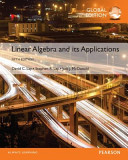
Linear Algebra and Its Applications, Global Edition
By - Lay, David C.
Floor
-
Floor 2
Published
-
Pearson Education Limited, Harlow, 2016
ISBN 10 - 1292092238
ISBN 13 - 9781292092232
Book Status
-
1 Qnty Available with us.
Subject
-
Algebras, Linear
Shelf No
-
2
Call Number
-
512.5 LAY
Edition
-
5th ed.
Physical Description
-
1 volume (various pagings) : illustrations (some color) ; 24 cm
Notes
-
Includes Index